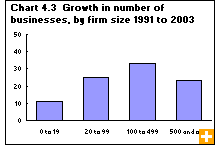Business performance and ownership
No matter how big or how small, every business enterprise in Canada started as an idea. At one time or another, an entrepreneur with some seed money and lots of energy decided to take a risk and set up shop—as a dry cleaner, computer manufacturer, trader, restaurateur, or even an emu farmer.
Their risk-taking and hard work has paid off: Canadian firms have more than doubled their overall operating profits from $112.1 billion in 1998 to $243.6 billion in 2006. Non-financial businesses, such as mining, theatre companies or Internet services, accounted for 72% of total operating profits; finance and insurance accounted for the rest.
Companies generating the biggest revenue are those supplying Canadians and the rest of the economy with goods—our manufacturers, wholesalers and retail stores. Together, they generated over $1,571.0 billion in revenue and $73.3 billion in profit in 2006. Homebuilders and other construction companies garnered another $197.8 billion in revenue that year, followed closely by companies in the fast-growing oil and gas patch, at $157.4 billion. Banks and insurance companies together took in about $275.8 billion in revenue.
Bigger revenues, bigger profits?
Bigger revenues, however, do not always translate into bigger profits. In 2006, Canada’s manufacturers, wholesalers and retailers were among the least profitable businesses, with an average profit margin of about 5%. Meanwhile, companies in the real estate, rental and leasing industry, in mining and in the oil and gas industries boasted profit margins ranging from 18% to 21% in 2006. But financial institutions do the best: banks and credit card companies had profit margins of 26% and 41%, respectively.
Where’s the growth?
Growth closely follows economic trends. Companies supporting the oil and gas boom in Western Canada saw considerable revenue growth from 2001 to 2006, as did real estate companies throughout the country. The rapid growth of the Internet has also been good for many companies. Information and cultural industries have seen their revenues jump over the same period.
Medium and large businesses tend to be best able to exploit new business trends and prosper. From 1991 to 2003, the number of medium-sized firms (20 to 99 employees) increased 25%, while the number of larger companies (100 to 499 employees) grew 33%. That compares with just an 11% increase in the number of small businesses (0 to 19 employees).
Yet small businesses are by far the most numerous. More than 9 out of 10 businesses in Canada in 2003 had fewer than 20 employees. Collectively, however, these small businesses employ about 21% of all Canadian workers. To put that into perspective, a minority of large firms—about 2,000 out of more than 1 million companies—provide paycheques to 43% of all employees. These proportions have changed little from 1993 to 2003.
Companies use capital investment to fuel their growth. Canada’s small and medium-sized enterprises held debt totalling $377 billion in 2004. Without access to adequate capital, most small- to medium-sized companies cannot expand, launch new products or invest in research and development. Firms with 1 to 4 employees carried an average debt of $187,000. Those employing 5 to 19 people were $489,000 in debt, while businesses with 20 to 99 employees owed an average $2.2 million.
Business bankruptcies down to a 25-year low
Although business financing is the fuel of our economy, debts can pile up. And without strong operating profits to pay down the money owed, many businesses declare bankruptcy each year. However, a recent study showed that the rate of business bankruptcies in Canada in 2005 declined to a 25-year low. Just 7 firms out of 1,000 went bankrupt in 2005.
Indicators show that Canadian businesses today are healthier and better able to withstand difficult times. For instance, the recessions and economic restructurings of the early 1980s and 1990s were accompanied by sharply higher rates of business bankruptcy, which peaked in 1982 and 1992. The economic slowdown from 2001 to 2002, however, did not result in a comparable increase in business failures. Bankruptcy rates, as well as average financial losses associated with bankruptcy, have declined significantly.
Share of business that are foreign-controlled remains stable
Some of the healthiest businesses in the Canadian economy are foreign-controlled and they have seen record profits in recent years. Despite their success, the share of foreign control among Canadian corporations remained stable in 2004—holding 22% of corporate assets in Canada and accounting for 30% of revenues. Aside from the odd fluctuation, these shares have remained fairly stable since the mid-1990s.
U.S.-controlled corporations are by far the biggest foreign players, accounting for 60% of foreign-controlled assets and revenues in 2004. After the United States, the biggest foreign players in the Canadian economy—as measured by both assets and revenues—are the United Kingdom, Germany, Japan, the Netherlands and France. In 2004, foreign control was highest in manufacturing (50% of total assets) and in oil and gas (45%).
Navigation and search
Note: This page contains several navigation menus. To enhance accessibility, most of these menus and the site search box are grouped in this section.
To find out more about accessibility features on our site, read our accessibility page.




